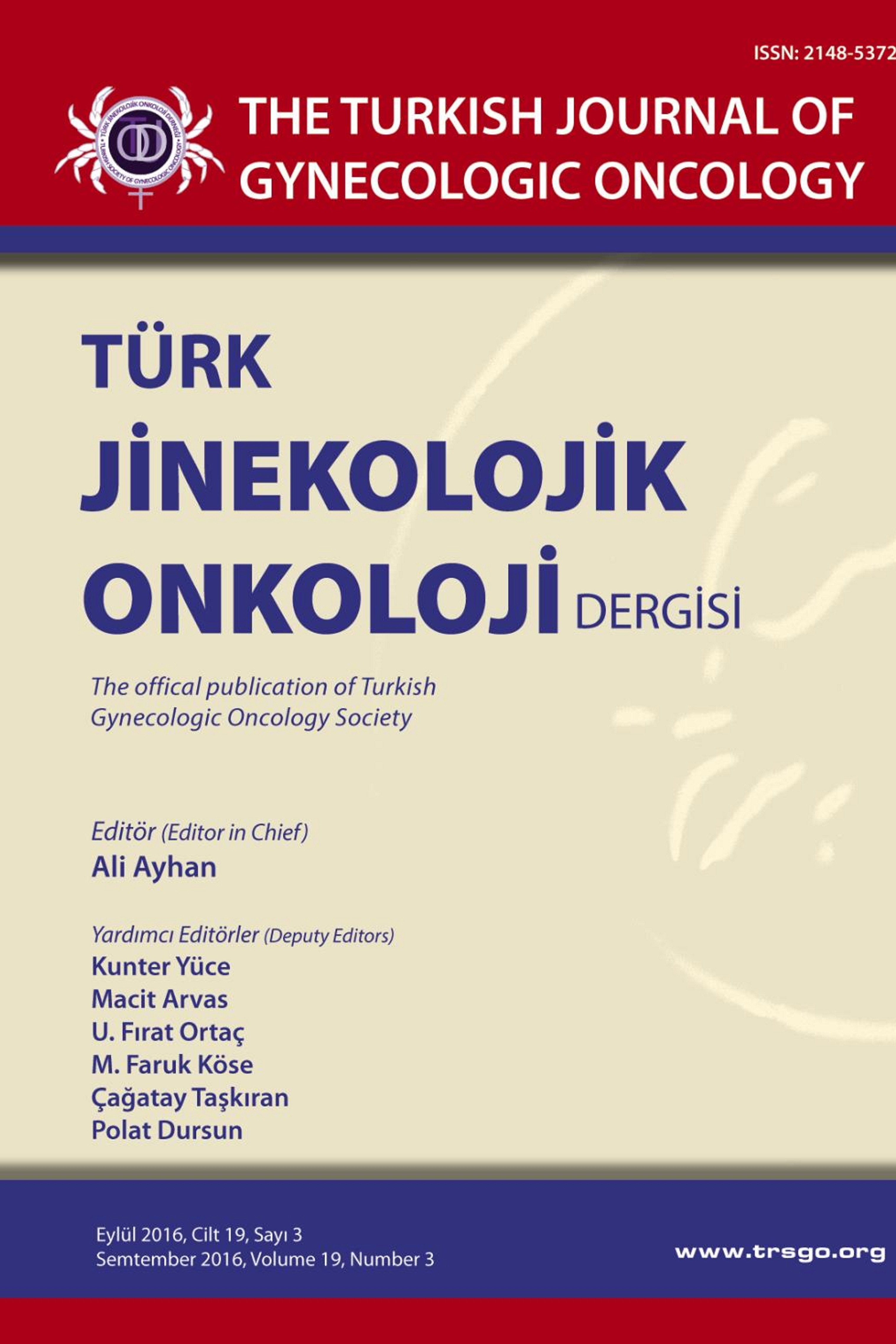BİR ÜNİVERSİTE HASTANESİNDE GESTASYONEL TROFOBLASTİK HASTALIK OLGULARININ DEĞERLENDİRİLMESİ
Gestasyonel trofoblastik hastalık, mol hidatiform, gestasyonel trofoblastik neoplazi
OUTCOMES OF PATIENTS WITH GESTATIONAL TROPHOBLASTIC DISEASE IN AN UNIVERSITY HOSPITAL
hydatidiform mole, gestational trophoblastic disease, gestational trophoblastic neoplasia.,
___
- 1. Schorge JO, Schaffer JI, Halvorson LM, Hoffman BL, Bradshaw KD, Cunningham FG. Williams Gynecology. McGraw Hill Companies, 2008.
- 2. Lurain JR. Gestational trophoblastic disease I: epidemiology, pathology, clinical presentation and diagnosis of gestational trophoblastic disease, and management of hydatidiform mole. Am J Obstet Gynecol. 2010;203(6):531-9.
- 3. Altieri A, Franceschi S, Ferlay J, Smith J, La Vecchia C. “Epidemiology and aetiology of gestational trophoblastic diseases”. Lancet Oncol. 2003;4:670-8.
- 4. Ozalp SS, Yalçin OT, Tanir HM. Hydatidiform mole in Turkey from 1932 to 2000. Int J Gynaecol Obstet. 2001;73:257- 8.
- 5. Ozalp SS, Oge T. Gestational trophoblastic diseases in Turkey. J Reprod Med. 2013;58:67-71.
- 6. Ozalp SS, Yalcin OT, Tanir HM. Hydatidiform mole at extreme ages of reproductive life in a developing country from 1932 to 2000. Eur J Gynaecol Oncol. 2002;23:361-2.
- 7. Gestational Trophoblastic Tumors Treatment - National Cancer Institute”. Retrieved in 21.3.2010.
- 8. Tidy JA, Gillespie AM, Bright N, Radstone CR, Coleman RE, Hancock BW. Gestational trophoblastic disease: a study of mode of evacuation and subsequent need for treatment with chemotherapy. Gynecol Oncol. 2000;78:309-12.
- 9. Soto-Wright V, Bernstein M, Goldstein DP, Berkowitz RS. The changing clinical presentation of complete molar pregnancy. Obstet Gynecol. 1995;86:775-9.
- 10. Cheung AN, Khoo US, Lai CY, et al. Metastatic trophoblastic disease after an initial diagnosis of partial hydatidiform mole: genotyping and chromosome in situ hybridization analysis. Cancer. 2004;100:1411-7.
- 11. Igwegbe A, Eleje G. Hydatidiform mole: A Review of Management Outcomes in a Tertiary Hospital in South-East Nigeria. Ann Med Health Sci Res. 2013;3:210-4.
- 12. Gulia S, Bajpai J, Gupta S, et al. Outcome of gestational trophoblastic neoplasia: experience from a tertiary cancer centre in India. Clin Oncol (R Coll Radiol). 2014;26:39-44.
- ISSN: 2148-5372
- Başlangıç: 2014
- Yayıncı: Türk Jinekolojik Onkoloji Derneği
RADİKAL JİNEKOLOJİK CERRAHİNİN ÜRİNER İNKONTİNANS’ A ETKİSİ
Tolgay Tuyan İLHAN, Ayşe Gül KEBAPÇILAR, Berat Berrin GENÇOĞLU, Türkan İLHAN, Tansel ÇAKIR, Çetin ÇELİK
TUBANIN MALİGN MİKST MÜLLERİAN TÜMÖRÜ: MORFOLOJİK AÇIDAN FARKLI İKİ OLGU
Cem ÇOMUNOĞLU, Özlem ÖNEN, Kübra BOYNUKALIN, Cem BAYKAL, Ali AYHAN
BİR ÜNİVERSİTE HASTANESİNDE GESTASYONEL TROFOBLASTİK HASTALIK OLGULARININ DEĞERLENDİRİLMESİ
Pınar SOLMAZ HASDEMİR, Tevfik GÜVENAL
Orhan ÜNAL, Önder SAKİN, Bülent KARS
BORDERLİNE OVER TÜMÖRLERİ: TANI,TEDAVİ, TAKİP
İNVAZİV DUKTAL MEME KANSERİNDE GEÇ GENİTAL NÜKS: OLGU SUNUMU
Mehmet Hakan YETİMALAR, Aylin ORGEN ÇALLI
Cem DANE, Hilal AŞIK, Selçuk ATALAY, Cansu BENLİ IŞIK
RETROPERİTONEAL VASKÜLER VARYASYONLAR VE JİNEKOLOJİK ONKOLOJİ CERRAHİSİNDEKİ ÖNEMİ
Murat ÖZ, Salim ERKAYA, Bülent ÖZDAL, Mehmet Mutjlu MEYDANLI, İlker SELÇUK, Tayfun GÜNGÖR
